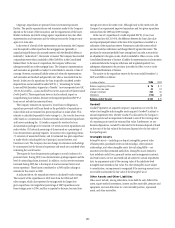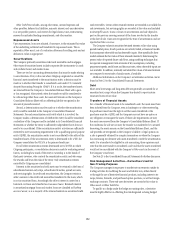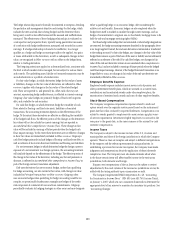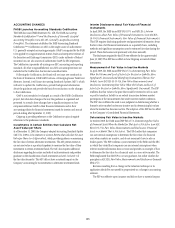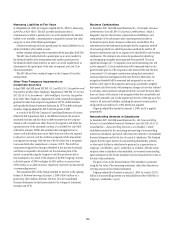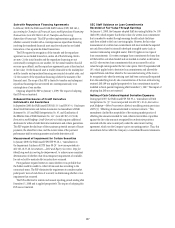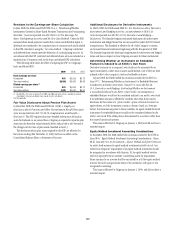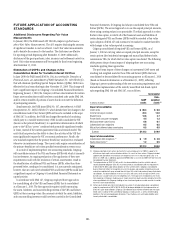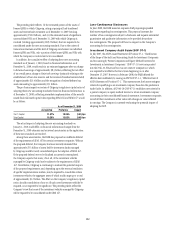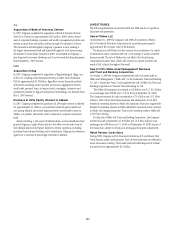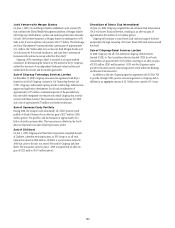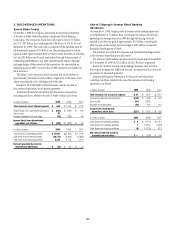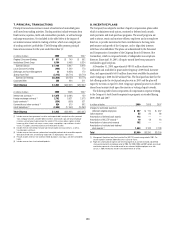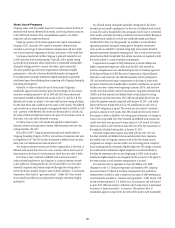Citibank 2009 Annual Report Download - page 151
Download and view the complete annual report
Please find page 151 of the 2009 Citibank annual report below. You can navigate through the pages in the report by either clicking on the pages listed below, or by using the keyword search tool below to find specific information within the annual report.
141
FUTURE APPLICATION OF ACCOUNTING
STANDARDS
Additional Disclosures Regarding Fair Value
Measurements
In January 2010, the FASB issued ASU 2010-06, Improving Disclosures
about Fair Value Measurements. The ASU requires disclosing the amounts
of significant transfers in and out of Level 1 and 2 fair value measurements
and to describe the reasons for the transfers. The disclosures are effective
for reporting periods beginning after December 15, 2009. Additionally,
disclosures of the gross purchases, sales, issuances and settlements activity in
Level 3 fair value measurements will be required for fiscal years beginning
after December 15, 2010.
Elimination of QSPEs and Changes in the
Consolidation Model for Variable Interest Entities
In June 2009, the FASB issued SFAS No. 166, Accounting for Transfers of
Financial Assets, an amendment of FASB Statement No. 140 (SFAS 166),
that will eliminate Qualifying Special Purpose Entities (QSPEs). SFAS 166 is
effective for fiscal years that begin after November 15, 2009. This change will
have a significant impact on Citigroup’s Consolidated Financial Statements.
Beginning January 1, 2010, the Company will lose sales treatment for certain
future asset transfers that would have been considered sales under SFAS 140,
and for certain transfers of portions of assets that do not meet the definition
of participating interests.
Simultaneously, the FASB issued SFAS No. 167, Amendments to FASB
Interpretation No. 46(R) (SFAS 167), which details three key changes to the
consolidation model. First, former QSPEs will now be included in the scope
of SFAS 167. In addition, the FASB has changed the method of analyzing
which party to a variable interest entity (VIE) should consolidate the VIE
(known as the primary beneficiary) to a qualitative determination of which
party to the VIE has “power” combined with potentially significant benefits
or losses, instead of the current quantitative risks and rewards model. The
entity that has power has the ability to direct the activities of the VIE that
most significantly impact the VIE’s economic performance. Finally, the
new standard requires that the primary beneficiary analysis be re-evaluated
whenever circumstances change. The current rules require reconsideration of
the primary beneficiary only when specified reconsideration events occur.
As a result of implementing these new accounting standards, Citigroup
will consolidate certain of the VIEs and former QSPEs with which it currently
has involvement. An ongoing evaluation of the application of these new
requirements could, with the resolution of certain uncertainties, result in
the identification of additional VIEs and former QSPEs, other than those
presented below, needing to be consolidated. It is not currently anticipated,
however, that any such newly identified VIEs and former QSPEs would have
a significant impact on Citigroup’s Consolidated Financial Statements or
capital position.
In accordance with SFAS 167, Citigroup employed three approaches
for consolidating all of the VIEs and former QSPEs that it consolidated
as of January 1, 2010. The first approach requires initially measuring
the assets, liabilities, and noncontrolling interests of the VIEs and former
QSPEs at their carrying values (the amounts at which the assets, liabilities,
and noncontrolling interests would have been carried in the Consolidated
Financial Statements, if Citigroup had always consolidated these VIEs and
former QSPEs). The second approach is to use the unpaid principal amounts,
where using carrying values is not practicable. The third approach is to elect
the fair value option, in which all of the financial assets and liabilities of
certain designated VIEs and former QSPEs would be recorded at fair value
upon adoption of SFAS 167 and continue to be marked to market thereafter,
with changes in fair value reported in earnings.
Citigroup consolidated all required VIEs and former QSPEs, as of
January 1, 2010 at carrying values or unpaid principal amounts, except for
certain private label residential mortgage and mutual fund deferred sales
commissions VIEs, for which the fair value option was elected. The following
tables present the pro forma impact of adopting these new accounting
standards applying these approaches.
The pro forma impact of these changes on incremental GAAP assets and
resulting risk-weighted assets for those VIEs and former QSPEs that were
consolidated or deconsolidated for accounting purposes as of January 1, 2010
(based on financial information as of December 31, 2009), reflecting
Citigroup’s present understanding of the new accounting requirements and
immediate implementation of the recently issued final risk-based capital
rules regarding SFAS 166 and SFAS 167, was as follows:
Incremental
In billions of dollars
GAAP
assets
Risk-
weighted
assets (1)
Impact of consolidation
Credit cards $ 86.3 $ 0.8
Commercial paper conduits 28.3 13.0
Student loans 13.6 3.7
Private label consumer mortgages 4.4 1.3
Municipal tender option bonds 0.6 0.1
Collateralized loan obligations 0.5 0.5
Mutual fund deferred sales commissions 0.5 0.5
Subtotal $134.2 $19.9
Impact of deconsolidation
Collateralized debt obligations (2) $ 1.9 $ 3.6
Equity-linked notes (3) 1.2 0.5
Total $137.3 $24.0
(1) Citigroup undertook certain actions during the first and second quarters of 2009 in support of its
off-balance-sheet credit card securitization vehicles. As a result of these actions, Citigroup included
approximately $82 billion of incremental risk-weighted assets in its risk-based capital ratios as of
March 31, 2009 and an additional approximate $900 million as of June 30, 2009. See Note 23 to the
Consolidated Financial Statements.
(2) The implementation of SFAS 167 will result in the deconsolidation of certain synthetic and cash
collateralized debt obligation (CDO) VIEs that were previously consolidated under the requirements
of ASC 810 (FIN 46(R)). Upon deconsolidation of these synthetic CDOs, Citigroup’s Consolidated
Balance Sheet will reflect the recognition of current receivables and payables related to purchased
and written credit default swaps entered into with these VIEs, which had previously been eliminated in
consolidation. The deconsolidation of certain cash CDOs will have a minimal impact on GAAP assets,
but will cause a sizable increase in risk-weighted assets. The impact on risk-weighted assets results
from replacing, in Citigroup’s trading account, largely investment grade securities owned by these VIEs
when consolidated, with Citigroup’s holdings of non-investment grade or unrated securities issued by
these VIEs when deconsolidated.
(3) Certain equity-linked note client intermediation transactions that had previously been consolidated
under the requirements of ASC 810 (FIN 46 (R)) will be deconsolidated with the implementation of
SFAS 167. Upon deconsolidation, Citigroup’s Consolidated Balance Sheet will reflect both the equity-
linked notes issued by the VIEs and held by Citigroup as trading assets, as well as related trading
liabilities in the form of prepaid equity derivatives. These trading assets and trading liabilities were
formerly eliminated in consolidation.


